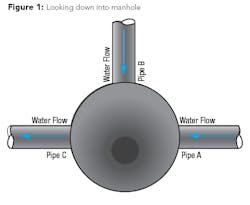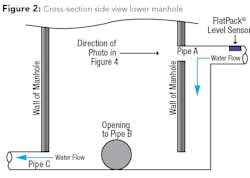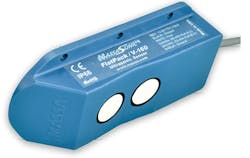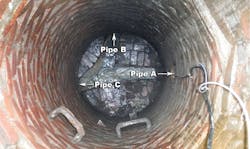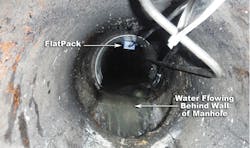By Donald P. Massa and Dawn Massa Stancavish
In order to reliably measure water flow within a complex sewer system, it is often necessary to accurately measure the level of the water as it flows in and out of the many manholes through the pipes within the system. Ultrasonic non-contact distance measurement technology is the most accurate and cost-effective method for measuring the water level within pipes because the ranges of the distance to be measured are very short due to the small diameters of the pipes.
Illustration looking down into the manhole showing the direction of the water flow in the 8-inch diameter pipes. Pipes A and B contain water that is flowing into the manhole, and the water flows out through Pipe C.
However, most ultrasonic sensors have two major problems performing the measurements in the operating environment of a sewer. The first is that the sensors typically have a minimum measuring range of 4 inches or longer, and they are also usually several inches thick. Therefore, if they are installed at the top of a pipe, they can’t measure the water level if it is closer than 6 or 7 inches from the top of the pipe. Since many of the pipes in a typical system are 8 inches or less in diameter, these sensors cannot obtain readings if the water level is higher than the lowest 10 percent of the pipe.
The second problem is that most ultrasonic sensors utilize transducers with very narrow radiation patterns that are typically around 10°. This means that the sound radiates from the sensor in a very narrow, conical 10° beam. This type of design allows the sensor to obtain longer detection ranges when the target is flat and perpendicular to the beam, but it does not work well when the reflecting surface is very uneven, such as occurs with the turbulent surface of water rapidly flowing in a pipe. This uneven surface causes the reflection of the sound pulse to scatter in many directions, so that the echo is outside the detection angle of a very narrow-beam transducer.
Illustration showing a cross-section side view of the lower portion of the manhole and the location of a flatpack level sensor in Pipe A. Pipes B and C are located at the bottom of the manhole, and Pipe A is located above them. The water flows out of Pipe A and down to the bottom behind the wall of the manhole. A FlatPack Level Sensor is mounted at the top of Pipe A, a short distance before it enters the manhole.
Ultrasonic sensors can be designed to overcome these problems and provide the accurate liquid level measurements required in sewer applications. To accomplish this, the mechanical design of the sensor must be very thin so that when mounted in a pipe, the transducers will be as close to the top as possible. In addition, the sensors should also contain two transducers: one for transmitting the ultrasonic sound pulse when it is driven by a large voltage, and the other to receive the echo reflected from the surface of the water.
Most ultrasonic sensors contain only one transducer that both transmits and receives the sound pulse. Because the transducer is a resonant device, the excitation voltage pulse causes it to ring like a bell that has been hit with a hammer. It takes time for this ringing voltage to slowly reduce until it is less than the levels produced by the reflecting echo when it returns to the transducer. This is why most ultrasonic sensors have a minimum detection range, or lockout, of 4 inches or more.
The MassaSonic FlatPack sensor
features a shallow 1-inch thickness and dual broad-beam transducer design.
If the sensor is designed with two transducers, the receiving transducer does not have a large transmit voltage place across it when the sound pulse is being generated. Therefore, the sensor can detect the low voltage pulse produced by the receiving transducer from the echo very quickly after the transmitting transducer has emitted the sound pulse.
Also, the transducers used in the sensors need to be designed with broader radiating patterns. If the transducers have beam angles that are approximately 20°, the echo caused by the turbulent surface of the rapidly flowing water will be detectable. In addition, the sensors should have an IP68 rating, since they will be completely submerged when a pipe is totally full during an unusually large water influx.
Figure 3. Looking down into one of the manholes in the Boston flow study (same view illustrated in Fig. 1).
An ultrasonic sensor that is both thin and contains dual transducer technology allows for more advanced sensing in such situations. Sending a signal on one transducer and receiving on another allows for closer detection of a target, even when the target is uneven or turbulent. This design is ideal for mounting in sewer pipes, and is why the MassaSonic® FlatPack® was chosen for a recent water flow study.
A local college in the MetroWest suburbs of Boston had to conduct a study in order to properly assess the impact of a needed infrastructure addition. The study showed how a slender ultrasonic sensor that utilized dual broad-beam transducer technology, such as the FlatPack, can effectively provide the required level detection in the pipes of a sewer system to enable reliable and accurate flow measurements.
Figure 4. Inside one of the manholes of the sewer system in the Boston flow study (looking into Pipe A, as illustrated in Fig. 2). One of the FlatPack Level Sensors can be seen mounted at the top of the 8-inch diameter Pipe A.
The entire program consisted of three separate flow studies that were carried out between January and June of 2017. During all three of these studies, the FlatPack Sensors were able to accurately measure the level of water in the pipes, which allowed for precise and repeatable measurements of the water flow during the entire flow study program. As a result, the maximum additional flow into the sewer was established, allowing the municipality and college to agree on additional allowed inflows and ancillary drainage planning. With the study completed, the college was granted approval to expand the requested infrastructure. WW
About the Authors: Donald P. Massa is chief technical officer and president of Massa Products Corporation in Hingham, Mass., and Dawn Massa Stancavish is the director of new products and business development. Founded in 1945 by Frank Massa, Massa Products Corporation is a family owned and operated electroacoustic company that designs, engineers, and manufactures ultrasonics for industry, and advanced sonars for military. Learn more at massa.com.
Circle No. 232 on Reader Service Card
